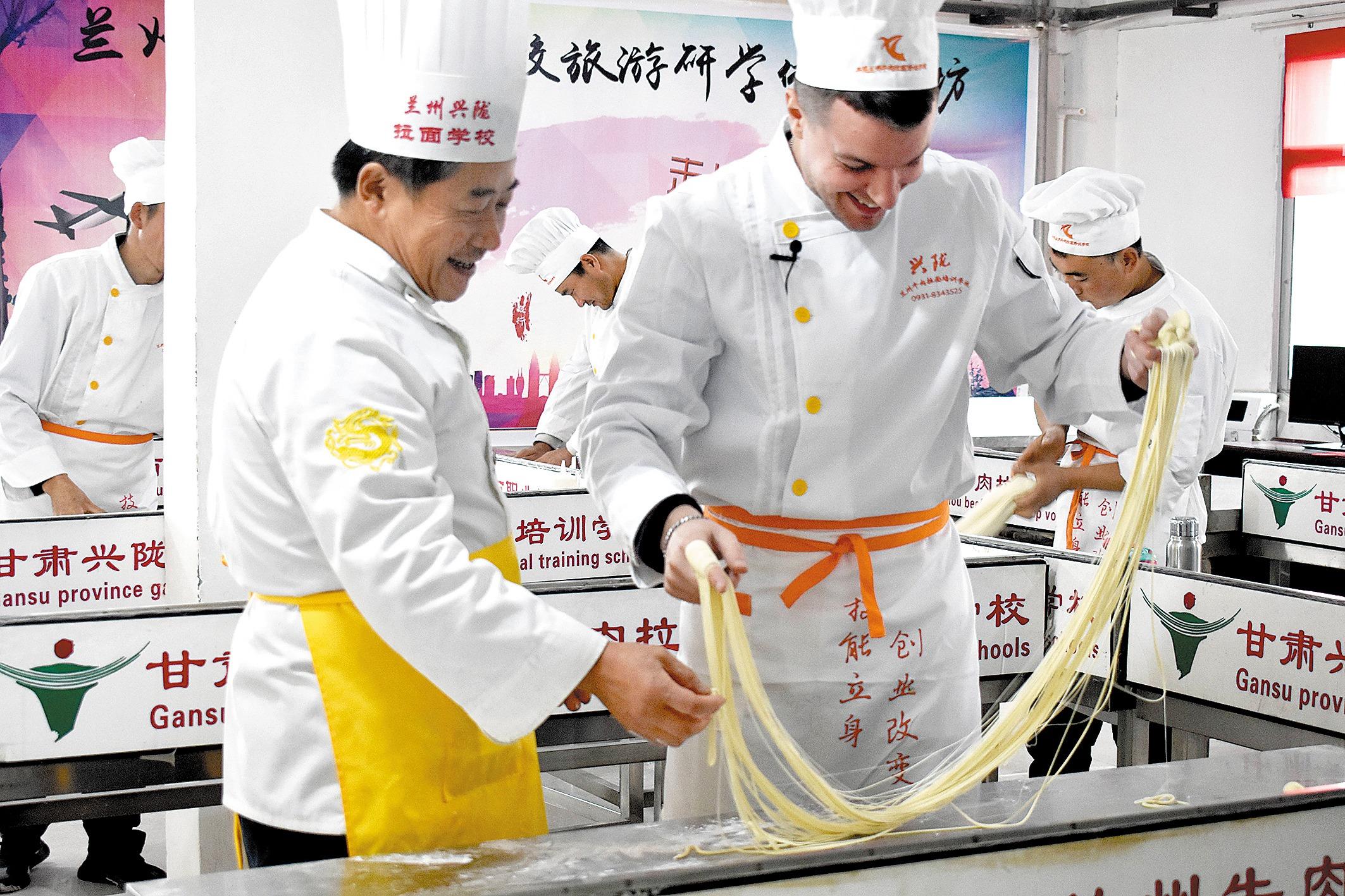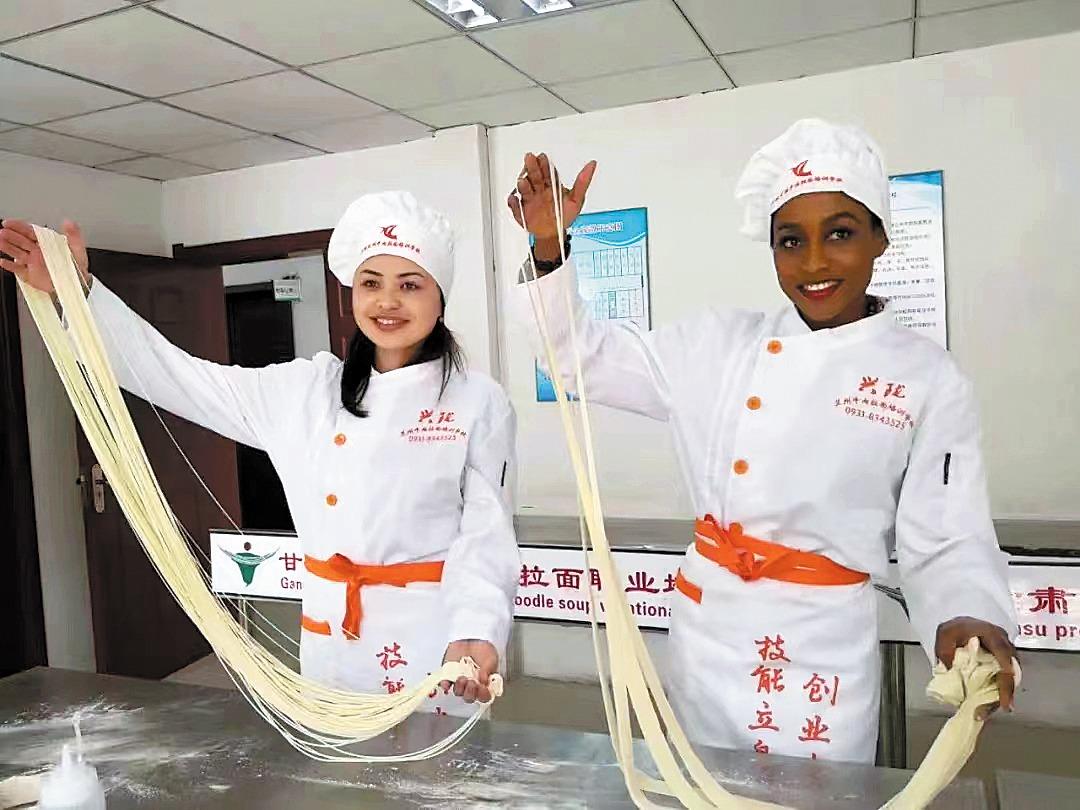Gansu launches study into Lanzhou beef noodles as they rise in popularity
 A traditional bowl of Lanzhou beef noodles includes clear soup, radish, chili oil, coriander and leek, as well as beef and noodles. (PHOTO PROVIDED TO CHINA DAILY)
A traditional bowl of Lanzhou beef noodles includes clear soup, radish, chili oil, coriander and leek, as well as beef and noodles. (PHOTO PROVIDED TO CHINA DAILY)
In Lanzhou, Gansu province, the day, for many locals, begins with a hot, steaming bowl of beef noodles. A traditional bowl must have the following ingredients and colors, in addition to beef: white radish, red chili oil, green coriander and leek, and yellow noodles.
According to a Northwest Minzu University report, more than 1,600 shops sell beef noodles in Lanzhou. Despite the large number, some would-be customers find it difficult to get a table, such is the demand to sample the bowl of delight. They usually place their bowls on a chair and sit on something lower, soaking in the bustling atmosphere of a beloved morning ritual.
Lanzhou beef noodles have become a staple food item nationally, from the dish’s humble and rugged origins in small workshops to evolving as a specialty in fashionable restaurants and gaining in appeal among overseas Chinese.
A legislative research project of the Gansu Provincial People’s Congress Standing Committee for 2023 included studying “regulations on the development of the Lanzhou beef noodle industry”. Since then there has been heated discussion online on such topics as “Why does a bowl of noodles need legislation and will all Lanzhou noodles taste the same?”
A regulation, proposed by the Office of the Gansu Provincial Committee of the Chinese People’s Political Consultative Conference, points out that the province has yet to establish a “comparatively unified quality, technology and standards system” for beef noodles. Additionally, the production, processing and operation lack proper legal protection.
Zhao Xiaolong, secretary general of the Lanzhou Beef Noodle Industry Association, said the upcoming regulation aims to promote the development of the industry.
“It doesn’t only stipulate regulation on the taste of a bowl of noodles. It also aims to establish legislation in the area of industry development,” Zhao said.
 Visitors from countries involved in the Belt and Road Initiative learn how to make Lanzhou beef noodles at a training school in Lanzhou, Gansu province. (PHOTO PROVIDED TO CHINA DAILY)
Visitors from countries involved in the Belt and Road Initiative learn how to make Lanzhou beef noodles at a training school in Lanzhou, Gansu province. (PHOTO PROVIDED TO CHINA DAILY)
Ma Baozi, an elderly man from the Hui ethnic group, started to popularize Lanzhou beef noodles in 1915. In June 2021, the craft of making the noodles was included in the fifth batch of representative projects of national intangible cultural heritage.
Ma Wenbin, a fourth-generation maker of Lanzhou beef noodles, has been working on the dish since the age of 18. He is the noodle chef at the renowned Jinding Beef Noodle brand in Lanzhou. For him, this bowl has become an essential part of life. He said the predecessor of beef noodles was called hot pot noodles.
The first known maker of the beef noodles, Ma Baozi, would process and cook the liver of beef and lamb to make a clear soup, which he would carry along with the cooked cold noodles in a basket with a pot on his shoulders to sell along the city streets.
“Before eating noodles, customers were served a bowl of hot soup, called the ‘soup to clear’, and if they liked the soup, they could stay and have the noodles,” Ma Wenbin said.
He explained that to make Lanzhou noodles, high-quality beef is carefully selected. The leg bone, after the meat is removed, is smashed to release the flavor.
The beef is cut into pieces before being soaked in water. It is important to note that the blood-soaked water should not be discarded. After simmering the meat and bones for four hours, they are removed, and the stock is then added to the beef broth. The soup is gently stirred with a ladle, and any foam on the surface is skimmed off to ensure that the liquid is clear. This method is known as “hanging the soup”.
“A well-prepared soup is bright and clear, almost like a mirror or clearer than tap water. This is the hallmark of traditional clear-soup beef noodles,” Ma Wenbin said, adding that a key ingredient to making the noodles firm and elastic is the well-kneaded dough, produced in the right texture after some work.
Lanzhou beef noodles can be classified into more than 10 types based on their thickness, with each type having its own name. The noodle types are determined by the different age groups they are suitable for. For example, the thinner noodles are ideal for older people as they are easier to chew.
“This is why they are sometimes called ‘longevity noodles’. The elderly feel happy when eating them and often consume them regularly. They are also suitable for children because of the softer taste,” Ma Wenbin said.
 Visitors from countries involved in the Belt and Road Initiative learn how to make Lanzhou beef noodles at a training school in Lanzhou, Gansu province. (PHOTO PROVIDED TO CHINA DAILY)
Visitors from countries involved in the Belt and Road Initiative learn how to make Lanzhou beef noodles at a training school in Lanzhou, Gansu province. (PHOTO PROVIDED TO CHINA DAILY)
The thicker noodles are more suitable for younger people while the wider noodles may be loved by other individuals.
To enhance the flavor of the soup, more than 10 kinds of seasoning such as ginger peel, cumin and fennel seeds, and grass fruit are added.
In Lanzhou, noodle shops have their own recipes, giving rise to different styles of beef noodles across the city. Many of the well-known shops also have their own loyal patrons.
With some 500,000 shops in China and an estimated annual sales revenue of more than 400 billion yuan ($57.8 billion), Lanzhou beef noodles are also found abroad.
“Through continuous operation, innovation and development by generations of the Hui people, the Lanzhou noodles have gradually formed a unique style of clear soup, tender meat and thin noodles,” Zhao said.
“The dish is a ‘business card of Lanzhou’ and has an inseparable relationship with residents and society and the local economy,” he said.
Liang Shunjian, a renowned Lanzhou noodle chef, has been engaged in professional education, international chain development, cultural promotion and new product research and development.
He founded Jinweide Lanzhou Beef Noodle in 1990, which has developed to cover the entire industry chain and aims to spread noodle culture and appreciation.
In 2007, Liang edited and published The Encyclopedia of Lanzhou Beef Noodles, which became the first professional technical book on the topic. Used widely in teaching and research, the book has become a must-read for those who want to understand the culture, learn noodle-making techniques, and manage Lanzhou beef noodle shops.
In the same year, Liang also started the Gansu Xinlong Lanzhou Beef Noodle Vocational Training School to cultivate talent in the field. The school has trained thousands of students, including many from overseas. The noodle-experience workshop there has been selected as a research and practice education base for school students in Lanzhou.
In 2009, Liang went to Akita, Japan, for cultural exchanges as the “cultural ambassador” of Lanzhou beef noodles. In 2018, Jinweide introduced yak meat to further enhance the soup taste and it entered the overseas market by opening a store in Tokyo three years later.
Liang said their noodles have not only inherited the traditional beef soup style but also feature a vegetable noodle that caters to the balanced nutritional needs of modern people.
“Using scientific and technological methods, we extract the juice from various green vegetables and mix it with egg and dough, then use hand-pulling techniques to make the noodles,” Liang said.
The dish, with attributes such as being quick to consume, nutritious and delicious, represents the inheritance of Chinese culinary culture that is also going global.
Contact the writers at liyingxue@chinadaily.com.cn


